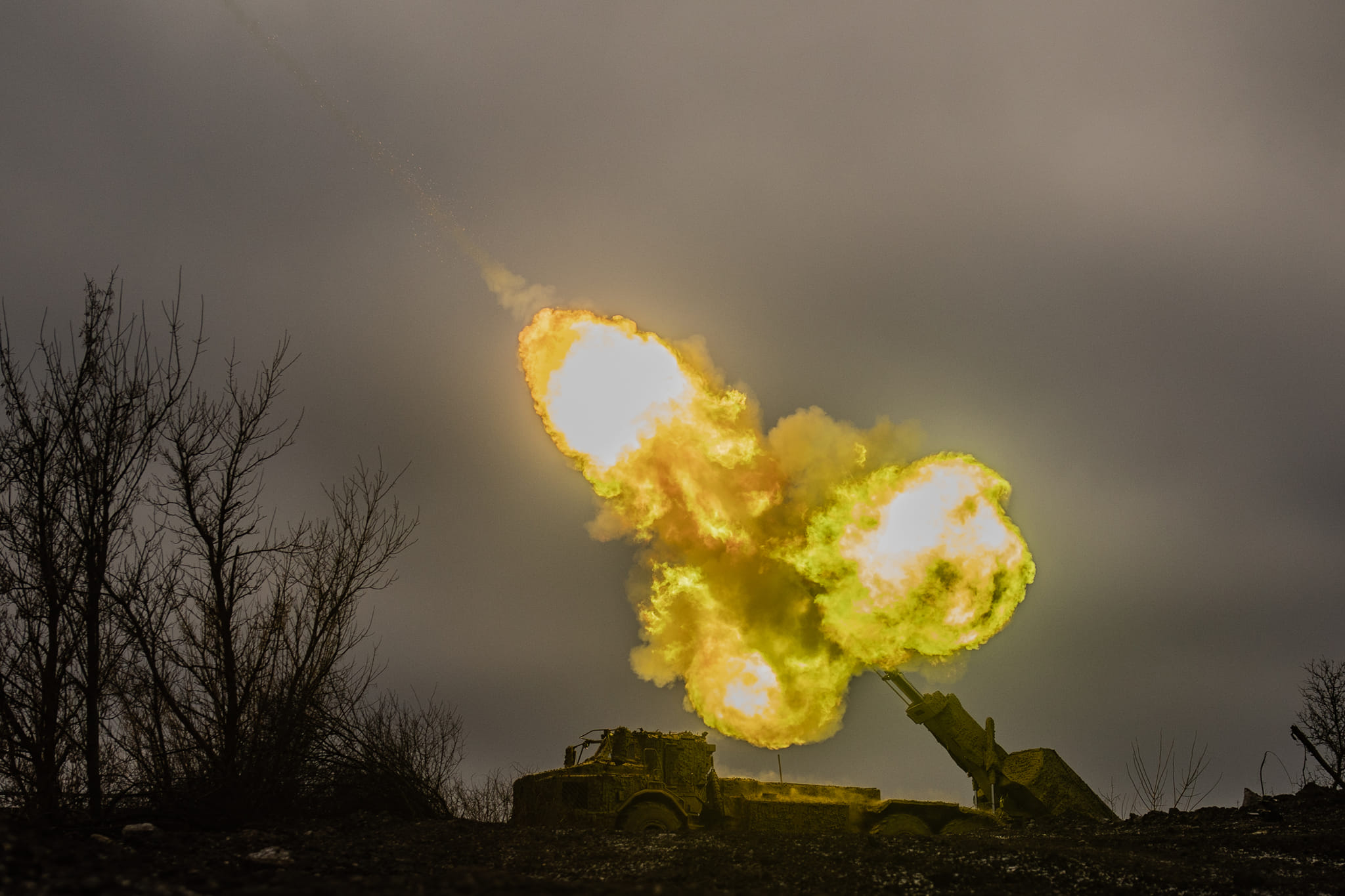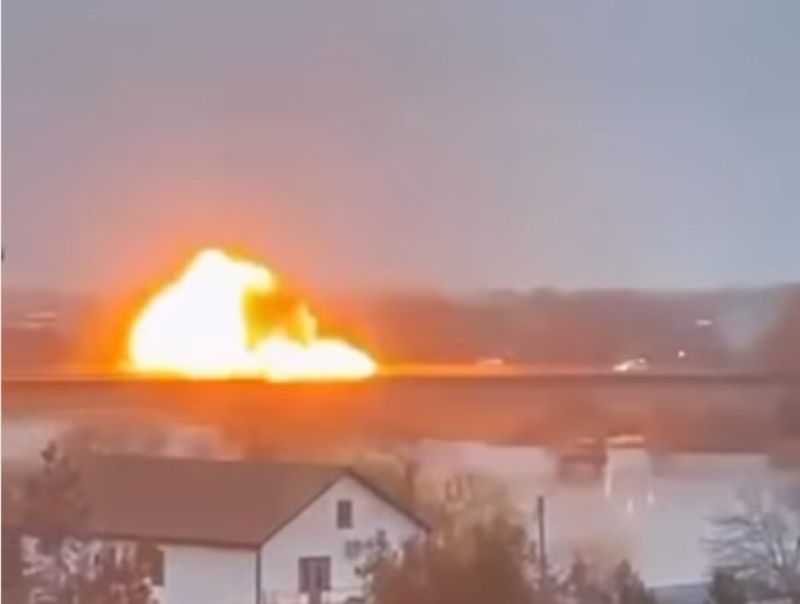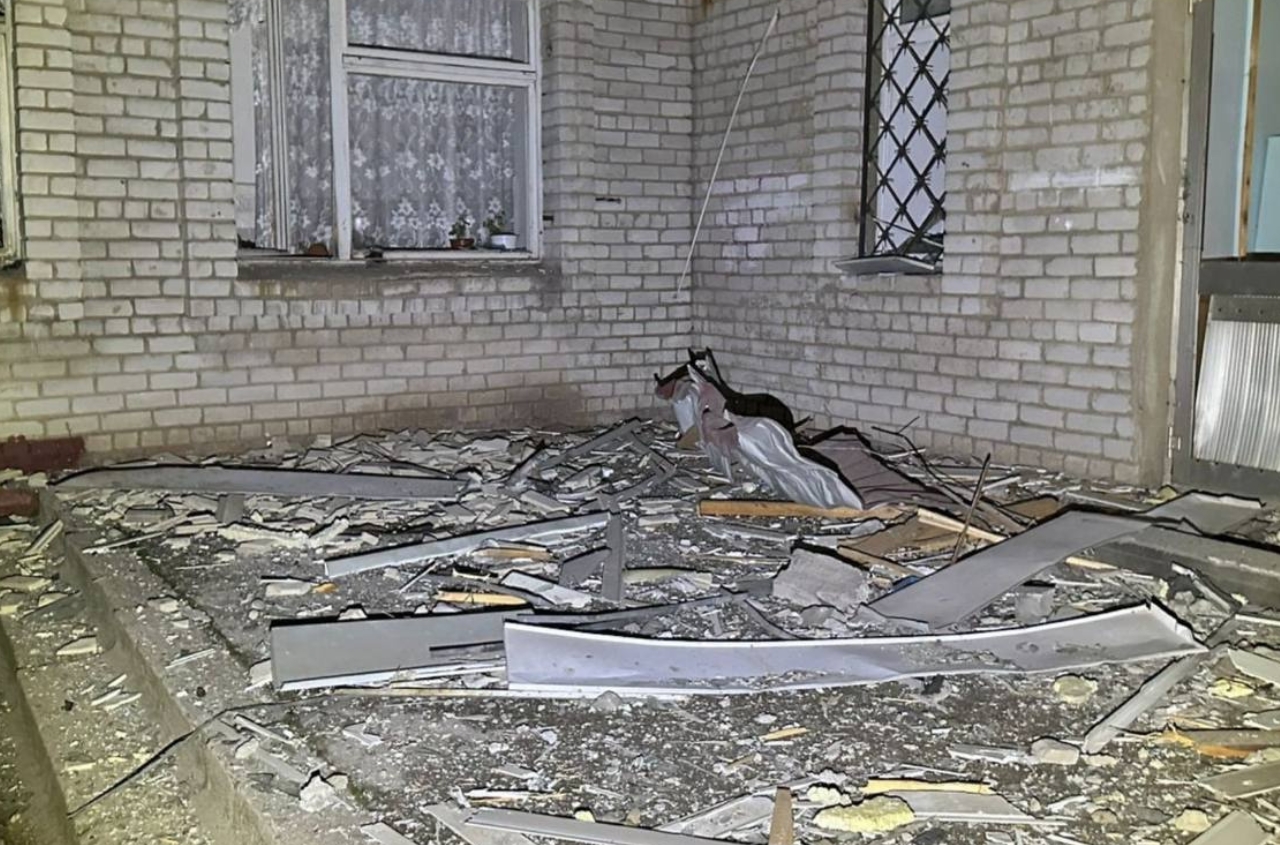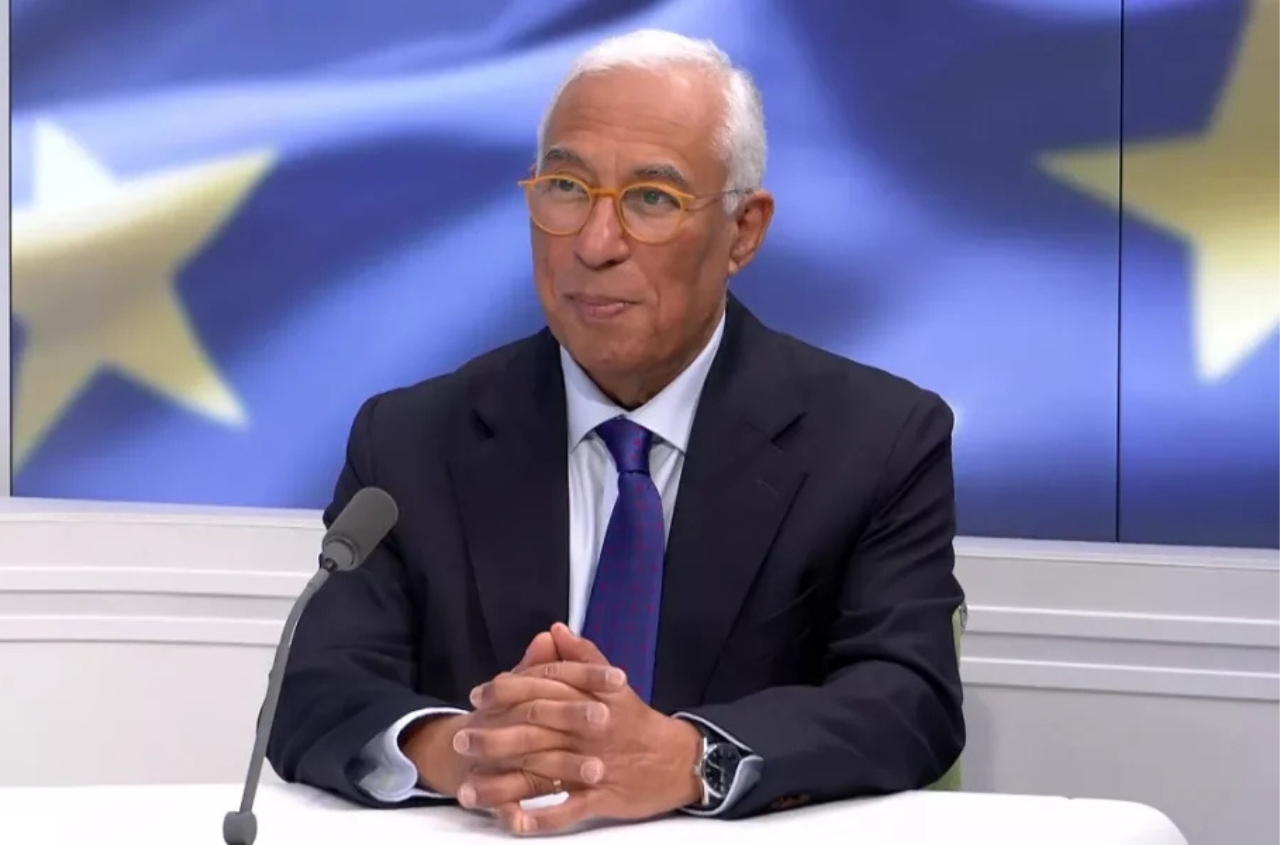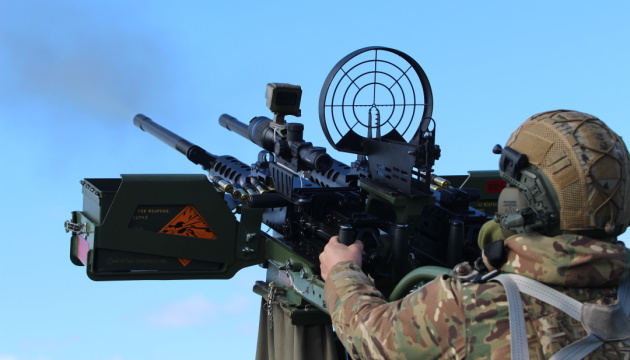A senior Ukrainian official reported that the Russian military intends to seize half of Ukraine by the end of 2026. However, Russian forces are highly unlikely to make such large advances in such a narrow time frame, given Russia’s current offensive capabilities and assuming the continued flow of Western aid to Ukraine.
Ukrainian Presidential Office Deputy Head Colonel Pavlo Palisa told reporters on June 5 that Russia likely aims to seize the full extent of Donetsk and Luhansk regions by September 1, 2025, and create a buffer zone along the northern Ukrainian-Russian border by the end of 2025. Palisa also stated that Russia intends to occupy all Ukrainian territory on the east (left) bank of the Dnipro River and seize Odesa and Mykolaiv regions by the end of 2026, effectively depriving Ukraine of access to the Black Sea.
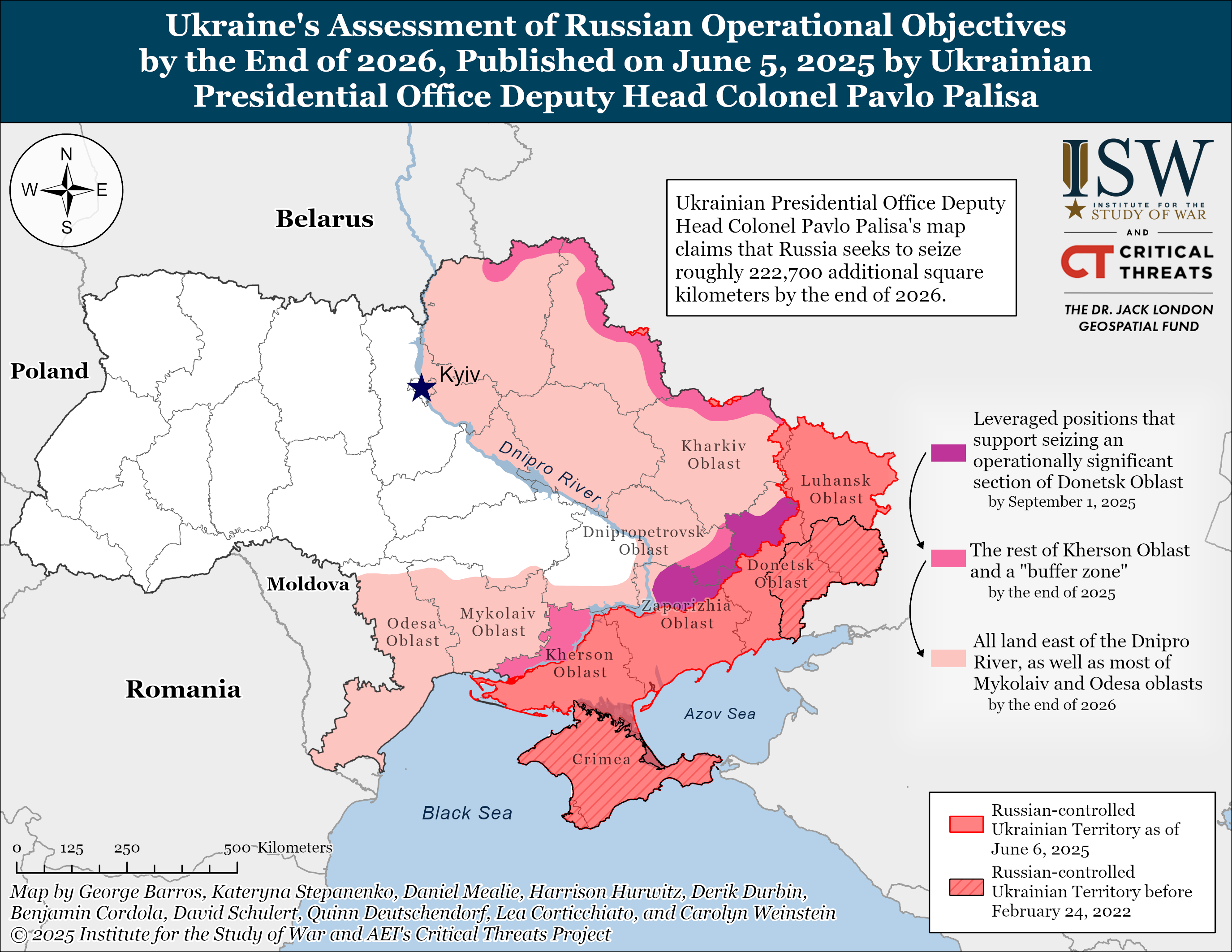
Western sources published a map on June 4 and 6 that Palisa reportedly presented to US officials and journalists. The map suggests Russia intends to seize roughly 222,700 additional square kilometers of Ukrainian territory, holding a total of 336,300 square kilometers by the end of 2026 — nearly double the approximately 162,000 square kilometers Russia controlled at the start of its full-scale invasion in 2022. For context, Ukraine’s total area is about 603,500 square kilometers.
Palisa’s map of purported Russian operational objectives suggests that Russian forces will attempt to seize and leverage positions in Zaporizhia and Dnipropetrovsk regions to support concurrent efforts to take the remainder of Donetsk and Luhansk regions before September 1, 2025. The map indicates that the Russian military command does not intend to seize Zaporizhzhia City by that date but aims to leverage these positions to eventually capture it, aligning with Russia’s formal territorial demands for the entire Zaporizhia region.
It remains unclear how Russian forces might seize the remainder of Donetsk region within three months or advance the 50 to 80 kilometers needed from the current frontline to the region’s administrative boundaries. Over the past 15 months, Russian advances between Avdiivka outskirts and positions near Pokrovsk have been only 30 to 50 kilometers—a pace far slower than required to control all of Donetsk by September 1. The map also assumes Russian forces can breach the heavily fortified Kostyantynivka-Kramatorsk-Slovyansk defensive belt—a line of fortified cities central to Ukraine’s defense in Donetsk—a feat Russian forces have not managed since their year-long, costly effort to seize Bakhmut ended in May 2023.
Palisa’s assessment further posits that Russian forces would sequentially attempt to capture the remainder of Kherson region and create a “buffer zone” along Ukraine’s northern border by the end of 2025. The map suggests Russian forces would attempt to cross the Dnipro River, retake the rest of Kherson region, push slightly further into Dnipropetrovsk region, and establish a defensible buffer zone along the international border in Chernihiv, Sumy, and Kharkiv regions by the end of 2025. Achieving these objectives would likely require significant redeployment of Russian troops from other parts of the frontline, assuming continued Western support for Ukraine.
Seizing the rest of Kherson region would be especially challenging, as it requires crossing the Dnipro River, establishing a foothold on the west (right) bank, capturing Kherson City, and advancing to the region’s administrative borders. Neither Ukrainian nor Russian forces have successfully conducted large-scale cross-river operations across the Dnipro since Russia withdrew to the east (left) bank of Kherson region in November 2022. Furthermore, Ukraine’s established defenses in west bank Kherson will significantly hinder any Russian attempts to regain the remainder of the region.
A series of intensified simultaneous Russian offensives into northern Chernihiv, Sumy, and Kharkiv regions would stretch Russian manpower and resources across the entire thousand-kilometer frontline, likely worsening existing operational constraints. These operational objectives align with Russia’s long-standing demands that Ukraine concede the illegally annexed Luhansk, Donetsk, Zaporizhia, and Kherson regions, as well as Crimea.
Looking further ahead to 2026, Russian military plans extend well beyond these formal demands, aiming to seize significant parts of central, southern, and eastern Ukraine. Palisa’s map suggests Russian forces intend to capture the entirety of Ukraine east of the Dnipro River, including the remaining unoccupied areas of Zaporizhia region, plus all of Chernihiv, Sumy, Kharkiv, and Poltava regions; half of Kyiv and Dnipropetrovsk regions; and parts of southern Ukraine west of the Dnipro River, including most of Odessa and Mykolaiv regions.
Achieving these goals would require Russian forces to capture nine currently unoccupied regional capitals — Zaporizhzhia, Odessa, Mykolaiv, Dnipro, Kharkiv, Sumy, Chernihiv, and Poltava — with a combined pre-war population of over 5.6 million people. Notably, Russia has not captured any regional capital since March 2022, when it seized Kherson City, which Ukraine recaptured eight months later. This campaign would also require Russian forces to advance over 300 kilometers from the furthest points of the international border to Kyiv within the next 18 months.
Russia’s purported military campaign plans for 2025 and 2026 are consistent with Kremlin narratives and statements by pro-Russian figures. Kremlin officials have repeatedly demanded the creation of a “buffer zone” along Ukraine’s northern border to protect Russian cities in Bryansk, Kursk, and Belgorod regions from Ukrainian attacks. The Kremlin also invokes the concept of “Novorossiya,” referring to all of eastern and southern Ukraine, to justify expansive territorial ambitions. Russian officials have characterized Kharkiv and Odessa cities as “Russian.” Andrei Kartapolov, Chair of the Russian State Duma Defense Committee, warned on May 31 that Ukraine risks losing Zaporizhzhia, Dnipro, Sumy, Kharkiv, Odessa, and Mykolaiv if it refuses peace talks soon.
Vladimir Saldo, the Russian-installed head of Kherson region occupation authorities, stated in April 2025 that “returning” the west (right) bank of the Dnipro River to Russia is “fundamentally important” and an “absolute priority.” He called for Russia to control the parts of the Dnipro River running through Kherson, Zaporizhia, and Dnipropetrovsk regions—a demand extending beyond currently occupied territory.
Russian Security Council Deputy Chair Dmitry Medvedev recently reiterated calls for Russia to occupy most of Ukraine as a buffer zone, except for a small rump state in Volyn and Lviv regions along Poland’s border. This underscores Russia’s expansive long-term territorial ambitions. While Palisa’s map does not indicate plans beyond 2026, it is unlikely Russian President Vladimir Putin would be satisfied with controlling just over half of Ukraine if military conditions allowed fulfilling these objectives.









